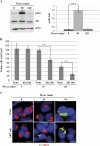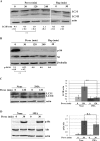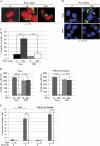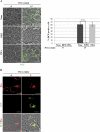Chelation of lysosomal iron protects dopaminergic SH-SY5Y neuroblastoma cells from hydrogen peroxide toxicity by precluding autophagy and Akt dephosphorylation
- PMID: 21742779
- PMCID: PMC3218672
- DOI: 10.1093/toxsci/kfr179
Chelation of lysosomal iron protects dopaminergic SH-SY5Y neuroblastoma cells from hydrogen peroxide toxicity by precluding autophagy and Akt dephosphorylation
Abstract
In human neuroblastoma SH-SY5Y cells, hydrogen peroxide (H(2)O(2), 200μM) rapidly (< 5 min) induced autophagy, as shown by processing and vacuolar relocation of light chain 3(LC3). Accumulation of autophagosome peaked at 30 min of H(2)O(2) exposure. The continuous presence of H(2)O(2) eventually (at > 60 min) caused autophagy-dependent annexin V-positive cell death. However, the cells exposed to H(2)O(2) for 30 min and then cultivated in fresh medium could recover and grow, despite ongoing autophagy. H(2)O(2) rapidly (5 min) triggered the formation of dichlorofluorescein-sensitive HO(·)-free radicals within mitochondria, whereas the mitochondria-associated oxidoradicals revealed by MitoSox (O(2)(·-)) became apparent after 30 min of exposure to H(2)O(2). 3-Methyladenine inhibited autophagy and cell death, but not the generation of HO(·). Genetic silencing of beclin-1 prevented bax- and annexin V-positive cell death induced by H(2)O(2), confirming the involvement of canonical autophagy in peroxide toxicity. The lysosomotropic iron chelator deferoxamine (DFO) prevented the mitochondrial generation of both HO(.) and O(2)(·-) and suppressed the induction of autophagy and of cell death by H(2)O(2). Upon exposure to H(2)O(2), Akt was intensely phosphorylated in the first 30 min, concurrently with mammalian target of rapamycin inactivation and autophagy, and it was dephosphorylated at 2 h, when > 50% of the cells were dead. DFO did not impede Akt phosphorylation, which therefore was independent of reactive oxygen species (ROS) generation but inhibited Akt dephosphorylation. In conclusion, exogenous H(2)O(2) triggers two parallel independent pathways, one leading to autophagy and autophagy-dependent apoptosis, the other to transient Akt phosphorylation, and both are inhibited by DFO. The present work establishes HO(·) as the autophagy-inducing ROS and highlights the need for free lysosomal iron for its production within mitochondria in response to hydrogen peroxide.
Figures













Similar articles
-
Iron chelator Deferoxamine protects human neuroblastoma cell line SH-SY5Y from 6-Hydroxydopamine-induced apoptosis and autophagy dysfunction.J Trace Elem Med Biol. 2020 Jan;57:126406. doi: 10.1016/j.jtemb.2019.126406. Epub 2019 Sep 20. J Trace Elem Med Biol. 2020. PMID: 31570251
-
Oxidative stress induces parallel autophagy and mitochondria dysfunction in human glioma U251 cells.Toxicol Sci. 2009 Aug;110(2):376-88. doi: 10.1093/toxsci/kfp101. Epub 2009 May 18. Toxicol Sci. 2009. PMID: 19451193
-
Inhibition of PI3k class III-dependent autophagy prevents apoptosis and necrosis by oxidative stress in dopaminergic neuroblastoma cells.Toxicol Sci. 2010 Sep;117(1):152-62. doi: 10.1093/toxsci/kfq170. Epub 2010 Jun 4. Toxicol Sci. 2010. PMID: 20525898
-
Cathepsin D-Bax death pathway in oxidative stressed neuroblastoma cells.Free Radic Biol Med. 2007 May 1;42(9):1305-16. doi: 10.1016/j.freeradbiomed.2006.12.030. Epub 2007 Jan 8. Free Radic Biol Med. 2007. PMID: 17395004
-
Arylpiperazine-mediated activation of Akt protects SH-SY5Y neuroblastoma cells from 6-hydroxydopamine-induced apoptotic and autophagic death.Neuropharmacology. 2013 Sep;72:224-35. doi: 10.1016/j.neuropharm.2013.04.037. Epub 2013 May 3. Neuropharmacology. 2013. PMID: 23643751
Cited by
-
Mild MPP+ exposure-induced glucose starvation enhances autophagosome synthesis and impairs its degradation.Sci Rep. 2017 Apr 26;7:46668. doi: 10.1038/srep46668. Sci Rep. 2017. PMID: 28443637 Free PMC article.
-
Overexpression of parkin rescues the defective mitochondrial phenotype and the increased apoptosis of Cockayne Syndrome A cells.Oncotarget. 2016 Jun 7;8(61):102852-102867. doi: 10.18632/oncotarget.9913. eCollection 2017 Nov 28. Oncotarget. 2016. PMID: 29262528 Free PMC article.
-
Guidelines for the use and interpretation of assays for monitoring autophagy (4th edition)1.Autophagy. 2021 Jan;17(1):1-382. doi: 10.1080/15548627.2020.1797280. Epub 2021 Feb 8. Autophagy. 2021. PMID: 33634751 Free PMC article.
-
Deferiprone protects against photoreceptor degeneration by inhibiting parthanatos.Cell Death Dis. 2025 May 19;16(1):402. doi: 10.1038/s41419-025-07686-x. Cell Death Dis. 2025. PMID: 40389413 Free PMC article.
-
Epigenetic control of autophagy by microRNAs in ovarian cancer.Biomed Res Int. 2014;2014:343542. doi: 10.1155/2014/343542. Epub 2014 Apr 30. Biomed Res Int. 2014. PMID: 24877083 Free PMC article.
References
-
- Arico S, Petiot A, Bauvy C, Dubbelhuis PF, Meijer AJ, Codogno P, Ogier-Denis E. The tumor suppressor PTEN positively regulates macroautophagy by inhibiting the phosphatidylinositol 3-kinase/protein kinase B pathway. J. Biol. Chem. 2001;276:35243–35246. - PubMed
-
- Arsham AM, Neufeld TP. Thinking globally and acting locally with TOR. Curr. Opin. Cell. Biol. 2006;18:589–597. - PubMed
-
- Bilski P, Belanger AG, Chignell CF. Photosensitized oxidation of 2′,7′-dichlorofluorescin: Singlet oxygen does not contribute to the formation of fluorescent oxidation product 2′,7′-dichlorofluorescein. Free Radic. Biol. Med. 2002;33:938–946. - PubMed
Publication types
MeSH terms
Substances
Grants and funding
LinkOut - more resources
Full Text Sources
Medical
Research Materials

